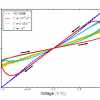The mathematical foundations of electronics predict the existence of four fundamental electronic devices. The resistor, capacitor and inductor are well known. The fourth device, the memristor, was only discovered in 2008 and even now remains an exotic piece of kit. Memristors are electrical elements whose resistance depends on the current that has passed through it in the past, a phenomenon that physicists call a hysteresis. This makes these devices behave like resistors with memory, hence their name. Memristors have generated considerable interest because they are simple and cheap to make, operate quickly and at low power and have the potential to store information even when the power is switched off. So it’s no surprise that great things are expected of them and that various plans are afoot to build them into future generations of microchips. But there’s a potential fly in the ointment: noise. In practice, the behaviour of memristors is quite simple. Plot the voltage across a memristor against the current flowing through it and you’ll get a figure-of-eight curve like the one above. It’s easy to imagine that noise could swamp this effect, destroying the memory that makes memristors so useful. Today, Alexander Stotland and Massimiliano Di Ventra at the University of California-San Diego, reveal a comprehensive analysis of the effects of noise on memristors. Their conclusion is both surprising and reassuring. Not only should memristors be immune to most types of noise, their memory ought to be enhanced by it. (via Next Generation Memories Will Be Improved By Noise – Technology Review
) via the New Shelton Wet/Dry
